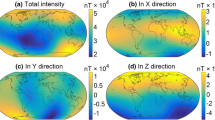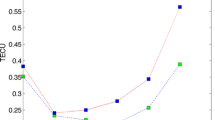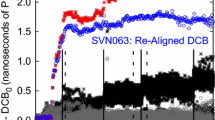Abstract
The global positioning system (GPS) differential code biases (DCB) provided by the International GNSS Service (IGS) show solar-cycle-like variation during 2002–2013. This study is to examine whether this variation of the GPS DCBs is associated with ionospheric variability. The GPS observations from low earth orbit (LEO) satellites including CHAMP, GRACE and Jason-1 are used to address this issue. The GPS DCBs estimated from the LEO-based observations at different orbit altitudes show a similar tendency as the IGS DCBs. However, this solar-cycle-like dependency is eliminated when the DCBs of 13 continuously operating GPS satellites are constrained to zero-mean. Our results thus revealed that ionospheric variation is not responsible for the long-term variation of the GPS DCBs. Instead, it is attributed to the GPS satellite replacement with different satellite types and the zero-mean condition imposed on all satellite DCBs.





Similar content being viewed by others
References
Blewitt G (1990) An automatic editing algorithm for GPS data. Geophys Res Lett 17:199–202. doi:10.1029/GL017I003P00199
Coco DS, Coker C, Dahlke SR, Clynch JR (1991) Variability of GPS satellite differential group delay biases. IEEE Trans Aerosp Electron Syst 27:931–938. doi:10.1109/7.104264
Foelsche U, Kirchengast G (2002) A simple “geometric’’ mapping function for the hydrostatic delay at radio frequencies and assessment of its performance. Geophys Res Lett 29:1473. doi:10.1029/2001GL013744
Hernández-Pajares M, Juan JM, Sanz J, Orus R, Garcia-Rigo A, Feltens J, Komjathy A, Schaer SC, Krankowski A (2009) The IGS VTEC maps: a reliable source of ionospheric information since 1998. J Geod 83:263–275. doi:10.1007/S00190-008-0266-1
Lanyi GE, Roth T (1988) A comparison of mapped and measured total ionospheric electron content using global positioning system and beacon satellite observations. Radio Sci 23:483–492. doi:10.1029/RS023I004P00483
Lei J, Wang W, Burns AG, Yue X, Dou X, Luan X, Solomon SC, Liu YC-M (2014) New aspects of the ionospheric response to the October 2003 superstorms from multiple-satellite observations. J Geophys Res 119:2298–2317. doi:10.1002/2013JA019575
Mannucci AJ, Wilson BD, Yuan DN, Ho CH, Lindqwister UJ, Runge TF (1998) A global mapping technique for GPS-derived ionospheric total electron content measurements. Radio Sci 33:565–582. doi:10.1029/97RS02707
Mannucci AJ, Tsurutani BT, Iijima BA, Komjathy A, Saito A, Gonzalez WD, Guarnieri FL, Kozyra JU, Skoug R (2005) Dayside global ionospheric response to the major interplanetary events of October 29–30, 2003 “Halloween storms”. Geophys Res Lett 32:L12S02. doi:10.1029/2004GL021467
Rideout W, Coster A (2006) Automated GPS processing for global total electron content data. GPS Solut 10:219–228. doi:10.1007/S10291-006-0029-5
Sardón E, Zarraoa N (1997) Estimation of total electron content using GPS data: how stable are the differential satellite and receiver instrumental biases? Radio Sci 32:1899–1910. doi:10.1029/97RS01457
Sardón E, Rius A, Zarraoa N (1994) Estimation of the transmitter and receiver differential biases and the ionospheric total electron content from global positioning system observations. Radio Sci 29:577–586. doi:10.1029/94RS00449
Schaer S (1999) Mapping and predicting the earth's ionosphere using the global positioning system. Ph.D. dissertation, Astronomical Institute, University of Bern, Bern, Switzerland
Warnant R (1997) Reliability of the TEC computed using GPS measurements—the problem of hardware biases. Acta Geod Geophys Hung 32:451–459. doi:10.1007/BF03325514
Yue X, Schreiner WS, Hunt DC, Rocken C, Kuo Y-H (2011) Quantitative evaluation of the low earth orbit satellite based slant total electron content determination. Space Weather 9:S09001. doi:10.1029/2011SW000687
Zhang DH, Shi H, Jin YQ, Zhang W, Hao YQ, Xiao Z (2014) The variation of the estimated GPS instrumental bias and its possible connection with ionospheric variability. Sci China Tech Sci 57:67–79. doi:10.1007/S11431-013-5419-7
Acknowledgments
The satellite data were provided by UCAR CDAAC (http://cdaac-www.cosmic.ucar.edu/cdaac/) and NASA (ftp://podaac-ftp.jpl.nasa.gov/). This work was supported by the National Natural Science Foundation of China (41325017, 41274157, 41174139, 41121003 and 41025016), the Project of Chinese Academy of Sciences (KZZD-EW-01), National Key Basic Research Program of China (2012CB825605) and Thousand Young Talents Program of China.
Author information
Authors and Affiliations
Corresponding author
Rights and permissions
About this article
Cite this article
Zhong, J., Lei, J., Dou, X. et al. Is the long-term variation of the estimated GPS differential code biases associated with ionospheric variability?. GPS Solut 20, 313–319 (2016). https://doi.org/10.1007/s10291-015-0437-5
Received:
Accepted:
Published:
Issue Date:
DOI: https://doi.org/10.1007/s10291-015-0437-5




